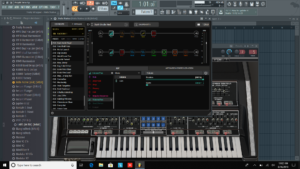Of course, guitar effects aren’t the sole domain of those rampaging hordes of axe-wielders. Synthesists, keyboardists, and drummers – especially e-drummers – also benefit from manipulating the sound of their instruments. The keen application of a flanger on John Henry Bonham’s drumming in Led Zeppelin’s Kashmir provided a sonic dreamscape throughout my teenage years and beyond.
Line 6 is known for their line of effects pedals. The Pod family especially holds a legendary status in the music industry. I use the Line 6 DL4 stompbox paired with a Yamaha MM8 for adding delay to pianos and their associated offspring. Read my love letter to the DL4 to get an idea of its high suitability for effecting keyboard tones.

In recent times, Line 6 earned accolades for its Helix multi-effects pedal. The Helix combines high-end signal processing with a graphical editing system resulting in great sound that’s easy to program. Combine virtual amplifiers, speaker cabinets, and effects to you heart’s content.
A plugin version – the Helix Native – provides the same functionality on a PC or Mac. Best of all – your patches are transferable between the hardware pedal and plugin. It also provides support for MIDI controllers and automation.
Line 6 Helix Native Plugin Features
- Accurate Models of Hundreds of Vintage Amps, Speakers, Mics, and Effects
- Innovative Graphical Programming Interface makes Patch Creation a Breeze
- Transfer Presets between Native and the Helix Family of Hardware Processors
- Available for Windows 7-10 and Mac OS X 10+
- Supports the AU, AAX, and VST Plugin Platforms
- Street Price of $399
If you are interested in high-end effects modeling for your DAW, Helix Native needs to be explored. Current owners of a Helix hardware pedal should check it out as well. Let’s dive a bit deeper into the details.
The Perfect Companion to a Line 6 Helix Stompbox
Helix Native partners nicely with a Helix hardware unit if you own one. Presets are mostly compatible between the desktop and the stompbox; you use the free Line 6 HX Edit application to transfer presets, setlists, and bundles back and forth. In fact, if you are already familiar with HX Edit, using Native becomes second nature, as both use a similar user interface for patch design.
The plugin includes features to help control a Helix stompbox in a live environment. Snapshots let you quickly choose between different parameter settings within a patch. Hardware controller assignments, Impulse Responses (audio files derived from running a test tone through an amp/speaker combo), and so much more are usable in both the plugin and the stompbox. HX Edit becomes your best friend when you own Helix Native along with the compatible hardware.
Helix Native provides a Deceptively Simple User Interface
If you are a veteran of using semi-complex plugins, working with Helix Native won’t be a problem. The user interface operates like many others, with the I/O meters and sliders on either side of the Signal Flow Window. The preset library and other utility functions reside at the top. Hiding the library de-clutters the UI nicely.
The Signal Flow Window is where the fun in Helix Native happens. Individual amps, cabinets, effects, and more are placed and routed to create a preset. You are able to create multiple signal paths within a preset, with the only limitation being the horsepower of your computer.
An Inspector Window lets you drag new components – called blocks – into the preset, as well as edit the parameters for existing ones. Yes Virginia, MIDI automation of those parameters is supported. There are hundreds of blocks; emulating a wide array of classic (and newer) amps, speakers, effects, and more. Deleting blocks and creating new routings is a breeze. Just manage the signal flow, man.
In short, if you are familiar with any relatively complex plugin – Reaktor comes to mind – Helix Native won’t cause you any problems. As always, take a look through the robust amount of factory presets to get an idea of what’s possible.
An Erector Set for Sound Design
As noted earlier, guitar effects aren’t just for guitarists anymore. To put Helix Native through its paces, I paired it with XILS-Labs excellent Polymoog emulation, PolyM. I found a suitable preset and went to town. A stunningly huge sound appeared out of my monitor speakers.
The combination of the PolyM patch (re: otherworldly 70s string synth inspired) and the Helix Native preset sounded powerful, full, and realistic. I saved the session for future use. After spending time auditioning and mangling presets as well as making a few of my own, it’s reasonable to expect Helix Native to be an important part of my software effects arsenal.
Occasionally, some digital distortion happened when the CPU usage peaked. Line 6 provides advice on optimizing the signal flow for performance. The most important takeaway is ensuring you use mono blocks if a stereo signal isn’t a requirement. Also, consider limiting your preset to one signal path.
For reference, my studio laptop sports Windows 10, a 7th generation Intel i5 processor with 8GB of RAM, and 256GB SSD.
Helix Native emulates Tons of Vintage Gear
The copious number of blocks in Helix Native features a cornucopia of legendary gear, from Line 6 as well as other manufacturers. One example relevant to my musical realm is the Cosmos Echo block, which emulates the classic Roland Space Echo – quite well, actually. Maestro, Boss, EHX, TC Electronic, Vox, Eventide, and MXR are just some of the manufacturers included.
Essentially, an erector set for sound design, Line 6 Helix Native belongs in the studio toolkit of any musician, even if they aren’t a guitarist or own a hardware version of the Helix. It’s an easy to use sandbox of sonic manipulation that plays well with synths, keyboards, and electric percussion. Add it to your plugin collection.
